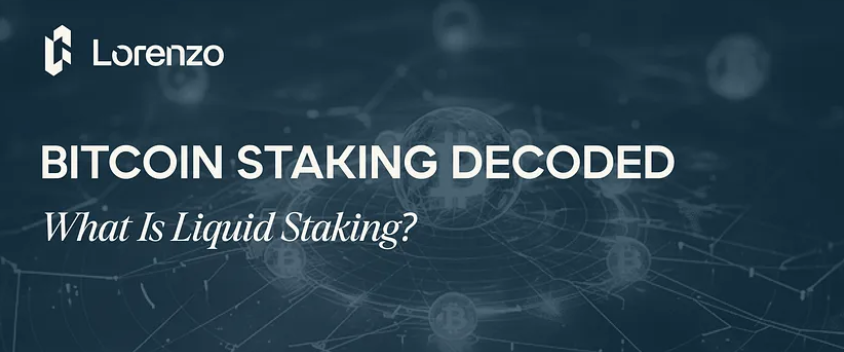Staking is the process of committing resources to a cause or investment while retaining ownership and the potential for gains or losses. In traditional finance, it often means investing with an expectation of rewards, balancing risk against potential returns.
However, blockchain technology has revolutionized these concepts. Decentralized finance (DeFi) has redefined traditional roles like lending and third-party involvement, with staking at the forefront of this transformation.
Liquid staking, a recent innovation in the blockchain sphere, offers a nuanced evolution of staking principles, enhancing security and utility. This article delves into liquid staking, a groundbreaking approach that combines the benefits of staking with improved liquidity and flexibility.
Proof Of Stake
The origins of staking lie in a key innovation in blockchain architecture — the proof-of-stake consensus mechanism.
The consensus mechanism of a blockchain is the system that determines which network participant gets the privilege of adding a block of new data to the permanent chain. A proof-of-work blockchain, such as bitcoin, bestows this privilege on the winner of a computational competition.
This blockchain secures the network by computing power; an opponent attempting to successfully attack such a network (“Bitcoin is backed by the largest computer network in the world, a network orders of magnitude larger than the combined size of the clouds that Amazon, Google, and Microsoft have built over the last 15–20 years.” Ark Invest’s Cathie Wood) would require having over 51% of this power.
In a sufficiently large network, such as bitcoin, having access to this many computational resources has now proven to be a de facto impossibility. And a “successful” attack only lasts for about 10 minutes: so per game theory, the would-be attacker simply counts the cost in advance of sustaining such an attack, and quickly learns that their resources would be better exhausted by simply buying more bitcoin.
Despite the extreme security of a proof-of-work blockchain, this mechanism makes the network inefficient in terms of both energy and output. It requires constantly running an enormous number of computers to secure the network. Proof of stake seeks to address these concerns.
A proof-of-stake blockchain hands out the privilege of adding a block at random to a small group of investors who have committed enough money to support the network. The far fewer participants needed means the network is substantially more efficient than proof-of-work chains.
Participants in a proof-of-stake blockchain commit value to the network by staking the blockchain’s native token. Staking tokens means locking them up in the network so they can’t be used for a set period of time; i.e., investor funds are not typically considered liquid, once staked.
A proof-of-stake chain is secured by the fact that attacking the network would require owning over 51% of all the staked coins. For a sufficiently large blockchain, this would not only be impractically expensive but also destroy the value of the staked tokens, thereby ruining the financial motive for attacking the network in the first place.
Why Stake?
To function, proof-of-stake networks need to convince users to stake their tokens, but users hesitate to do so because of the risks inherent in illiquidity.
Liquidity is the ability to use your assets, it’s the availability of capital to the market. Something is illiquid when it is not exchangeable; low liquidity means something is difficult to exchange, and high liquidity means something easy to exchange. Consider the differences between buried treasure, a house, and stone-cold cash.
When you stake your assets, you give up liquidity by locking the tokens, essentially burying them in the network for a set contracted time. This comes with certain risks that disincentivize participation in the network.
Since these tokens are locked, they can’t be sold in the sudden advent of a substantial price drop, meaning they could be worth far less when later unlocked. Additionally, they can’t be removed if a participant needs their money back, or the network is somehow compromised.
Proof-of-stake chains do not themselves mitigate this risk, but rather they pay users for taking it. The network acts similarly to how old-school bank savings accounts were designed. Today, proof-of-stake chains reward participants staking by paying a percentage back to the holder based on the size of their stake, which allows holders to earn true passive income on their holdings.
The Liquid Staking Revolution
But what if tokens could be staked and receive rewards without making the holder illiquid? It might sound contradictory, but this is the idea behind liquid staking. Liquid staking allows staking participants to remain liquid while still receiving rewards.
Here’s how:
Using a liquid staking protocol, participants deposit the native token they want to stake into the third-party liquid staking platform, instead of staking them directly with the native network. The platform then stakes the tokens themselves and issues a receipt token to the user who deposited funds.
Receipt tokens are redeemable for the native tokens initially deposited in the platform. Holders of these receipt tokens receive a percentage of the rewards that the platform earns by staking the original token directly in the network. The difference is that the user can use the receipt token to trade and participate in DeFI, thereby retaining their liquidity.
Of course, this token isn’t as liquid as the original because the market for the receipt token is significantly smaller. Further, the user pays a percentage of the staking reward to the liquid staking platform. However, for many users, this is a small price to pay for the freedom to benefit from the value of their staked tokens.
What Are The Benefits Of Liquid Staking?
The most obvious reasons investors prefer liquid staking, over traditional methods, follow directly from the ability to retain their liquidity. Receipt assets can be traded, sold, or used in other DeFi applications, providing liquidity while still earning staking rewards.
Some other benefits are less obvious:
- Access for small investors: Some proof-of-stake networks require a large minimum investment for staking. This bars smaller investors from contributing to the network and participating in governance. Through liquid staking, individuals can participate with smaller amounts because these platforms aggregate multiple users’ stakes to meet minimum requirements.
- Democratization: Although governance decisions ultimately lie with the liquid staking platform that manages the pools of staked tokens, these applications often provide mechanisms for its users to participate in voting for the native blockchain. This allows voting power to be distributed among the smaller investors who would otherwise not have any say in network decisions.
- Easy access: Navigating the process of staking cryptocurrency can be a daunting task for even the most technical retail investor. Liquid staking platforms make for user-friendly options for contributing to a favorite proof-of-stake blockchain.
What are the risks of liquid staking?
Blockchain exists to address the risks of centralized control in our financial systems. The risks of liquid staking are founded on foregoing the benefit of blockchain infrastructure’s decentralized nature, and instead locking your tokens into a centralized protocol.
- Smart contract vulnerabilities: Liquid staking protocols run on smart contracts, so a single bug or mistake in the contract can cause users to lose their funds if hackers exploit the vulnerability.
- Platform punishment: If the liquid staking platform acts maliciously against the native staking network, funds can be slashed by the network as a function of enforcing the proof-of-stake protocols.
- Redemption liquidity: The value of the receipt token depends on its ability to be converted to the original token via redemption. However, in some cases, mismanagement or liquidity crunch cripples the redemption process.
- Token Depeging: The trading price of the receipt token can fall below the market price of the underlying token due to a liquidity crunch on exchanges, simple unexpected news, or even the spreading of malicious fear, uncertainty and doubt (FUD) about any given project, or its team.
The Necessity Of Liquid Staking
The core benefits and risks of liquid staking are themselves an extension of the central dynamic at play in staking more generally — the back and forth between centralization and decentralization.
A proof-of-stake network comes with the built-in risks of centralization. It puts power over the network in the hands of a select few whale investors. Liquid staking both exacerbates this risk by pooling investor money into centralized points of control, and it mitigates risks by allowing smaller investors to contribute to the network freely.
This journey — from staking to liquid staking — reflects the broader evolution of blockchain technology as it adapts to overcome the unique challenges of decentralized finance.
 English
English
 Deutsch
Deutsch
 Español
Español
 Français
Français
 Português
Português
 日本
日本
 한국인
한국인
 Türkçe
Türkçe
 Русский
Русский
 Tiếng Việt
Tiếng Việt














